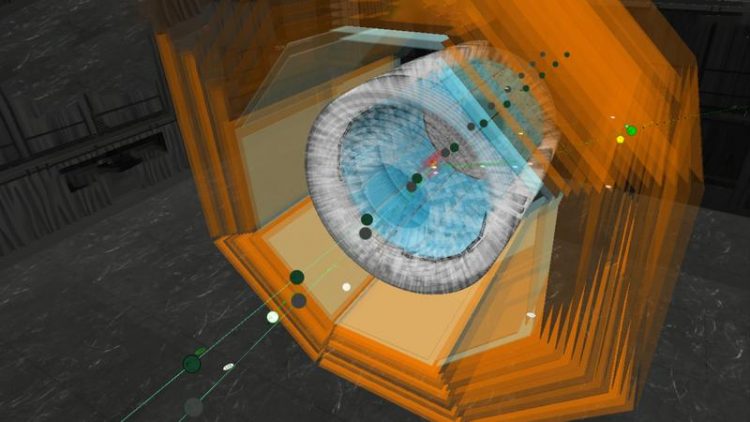Belle II yields the first results: In search of the Z′ boson

Collision events in the core of the Belle II detector KEK/Belle II
Scientists at 12 institutes in Germany are involved in constructing and operating the detector, developing evaluation algorithms, and analyzing the data.
The Max Planck Institute for Physics, the Semiconductor Laboratory of the Max Planck Society, the Ludwigs-Maximilians-Universität and the Technical University of Munich made leading contributions to the new development of the highly sensitive innermost detector, the Pixel Vertex Detector and the software for analyzing the data.
With the help of Belle II, scientists are looking for traces of new physics that can be used to explain the unequal occurrence of matter and anti-matter and the mysterious dark matter.
One of the so far undiscovered particles that the Belle II detector is looking for is the Z′ boson – a variant of the Z boson, which acts as an exchange particle for the weak interaction.
As far as we know, about 25 percent of the universe consists of dark matter, whereas visible matter accounts for just under 5 percent of the energy budget. Both forms of matter attract each other through gravity.
Dark matter thus forms a kind of template for the distribution of visible matter. This can be seen, for example, in the arrangement of galaxies in the universe.
Link between dark and normal matter
The Z′ boson may play an interesting role in the interaction between dark and visible matter, (i.e., it could be a kind of mediator between the two forms of matter). The Z′ boson can – at least theoretically – result from the collision of electrons (matter) and positrons (anti-matter) in the SuperKEKB and then decay into invisible dark matter particles.
The Z′ boson can thus help scientists to understand the behavior of dark matter. What’s more, the discovery of the Z′ boson could also explain other observations that are not consistent with the standard model, the fundamental theory of particle physics.
Important clue: Detection of muon pairs
But how can the Z′ boson be detected in the Belle II detector? Not directly – that much is sure. Theoretical models and simulations predict that the Z′ boson could reveal itself through interactions with muons, the heavier relatives of electrons. If scientists discover an unusually high number of muon pairs of opposite charge after the electron/positron collisions as well as unexpected deviations in energy and momentum conservation, this would be an important indication of the Z′ boson.
However, the new Belle II data has not yet provided any indication of the Z′ boson. But with the new data, the scientists can limit the mass and coupling strengths of the Z′ boson with previously unattainable accuracy.
More data, more precise analyses
“Despite the still small amount of data, we can now make measurements that have never been done before,” says the spokesperson of the German groups, Dr. Thomas Kuhr from the Ludwig Maximilian University of Munich. “This underlines the important role of the Belle II experiment in the study of elementary particles.”
These initial results come from the analysis of a small amount of data collected during the start-up phase of SuperKEKB in 2018. Belle II went into full operation on March 25, 2019. Since then, the experiment has been collecting data while continuously improving the collision rate of electrons and positrons.
If the experiment is perfectly tuned, it will provide considerably more data than in the recently published analyses. The physicists thus hope to gain new insights into the nature of dark matter and other unanswered questions.
The German working groups in the Belle II experiment are funded by the following institutions and programs:
European Research Council
Deutsche Forschungsgemeinschaft (DFG, German Research Foundation) under Germany´s Excellence Strategy
– “ORIGINS“: EXC-2094 – 390783311
– “Quantum Universe”: EXC-2121 – 390833306
German Federal Ministry of Education and Research (BMBF): BMBF funding of collaborative research “Exploring of the Universe and Matter” (ErUM)
Helmholtz Society
European Union’s Horizon 2020 – grant agreement No 822070
Max Planck Society
Prof. Dr. Thomas Kuhr
Ludwig-Maximilians-Universität München
thomas.kuhr@lmu.de
+49 89 35831-7174
Dr. Hans-Günther Moser
Max-Planck-Institut für Physik
moser@mpp.mpg.de
+49 89 32354-248
Search for an invisibly decaying Z’ boson at Belle II in e+e– ® m+ m– (e+ – m– +) + missing energy final states
The Belle II Collaboration
Phys. Rev. Lett. 124, 141801 – Published 6 April 2020
DOI:10.1103/PhysRevLett.124.141801
https://www.mpp.mpg.de/en/what-s-new/news/detail/belle-ii-liefert-erste-ergebnis…
Media Contact
All latest news from the category: Physics and Astronomy
This area deals with the fundamental laws and building blocks of nature and how they interact, the properties and the behavior of matter, and research into space and time and their structures.
innovations-report provides in-depth reports and articles on subjects such as astrophysics, laser technologies, nuclear, quantum, particle and solid-state physics, nanotechnologies, planetary research and findings (Mars, Venus) and developments related to the Hubble Telescope.
Newest articles

Silicon Carbide Innovation Alliance to drive industrial-scale semiconductor work
Known for its ability to withstand extreme environments and high voltages, silicon carbide (SiC) is a semiconducting material made up of silicon and carbon atoms arranged into crystals that is…

New SPECT/CT technique shows impressive biomarker identification
…offers increased access for prostate cancer patients. A novel SPECT/CT acquisition method can accurately detect radiopharmaceutical biodistribution in a convenient manner for prostate cancer patients, opening the door for more…

How 3D printers can give robots a soft touch
Soft skin coverings and touch sensors have emerged as a promising feature for robots that are both safer and more intuitive for human interaction, but they are expensive and difficult…





















